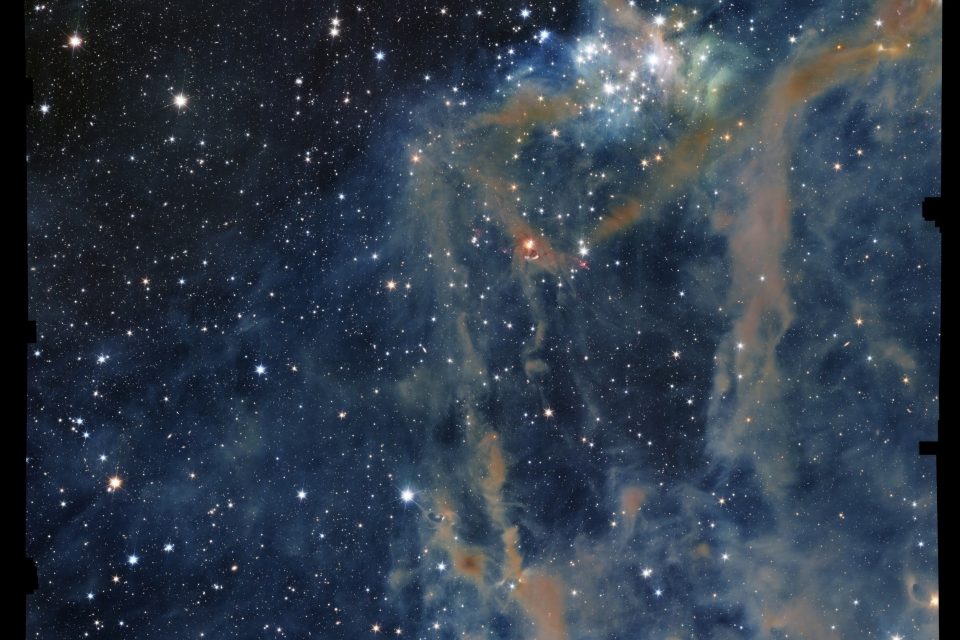Euclid captures a hidden nursery of stars in Orion’s dark cloud
Today’s Image of the Day from the European Space Agency features a shimmering stretch of cosmic dust and gas known as LDN 1641, a dark cloud that lies roughly 1,300 light-years from Earth.
This nebula sits within Orion, one of the most active star-forming regions in the Milky Way. What looks like a tranquil patch of night sky through an ordinary telescope bursts to life in this view from the European Space Agency’s Euclid space telescope.
Hidden stars behind the dust
When seen in visible light, this area appears almost empty. Dense curtains of dust hide most of the stars within and behind it, leaving only a faint scattering of light. But Euclid’s near-infrared instrument, NISP, pierces the gloom.
The telescope detects radiation invisible to human eyes, revealing a glowing tapestry where hundreds of stars shine through the haze.
Dust grains block visible light far more effectively than infrared, so Euclid’s instruments can see what ordinary optical telescopes cannot.
The result is an extraordinary portrait of a nebula in motion – a place where stars are being born inside cocoons of gas and dust.
The making of new suns
Many of the objects inside LDN 1641 are newborn stars still gathering mass. They pull in material from their surroundings and shoot out powerful jets of gas in opposite directions.
These outflows show up as magenta-colored coils and knots in the image. Each marks a young star’s attempt to shed the excess material that once fed it, a process that helps it stabilize and mature.
The nebula’s glowing filaments are both beautiful and instructive. They show astronomers how turbulence and gravity shape the earliest stages of stellar life.
In a few million years, the youngest stars here will burn away the remaining dust and emerge as bright blue-white beacons in Orion’s arm.
A window to the wider universe
In the upper left corner of Euclid’s image, the dust thins out, and the view extends much farther. Beyond the foreground stars of our galaxy, a quiet sea of distant galaxies becomes visible.
Each of those faint smudges represents a vast collection of billions of stars, some far older than the Sun, others still forming.
This small detail reminds researchers why Euclid exists: to map the large-scale structure of the universe.
By observing galaxies across cosmic time, scientists hope to understand the invisible forces – dark matter and dark energy – that shape how galaxies cluster and how the universe expands.
Hitting targets with amazing accuracy
Euclid captured this scene in September 2023, not as a planned scientific observation but as part of a guiding test.
Engineers needed to fine-tune the telescope’s ability to point precisely at specific patches of sky. To perform that test, they searched for an area with only a few visible stars. LDN 1641 fit the bill perfectly.
The results exceeded expectations. The data, covering about 0.64 square degrees of sky – more than three times the area of the full Moon – were gathered in less than five hours.
The test confirmed that Euclid could lock onto targets with remarkable accuracy, a crucial skill for mapping the heavens quickly and sharply.
Euclid’s mission: Mapping the invisible
Euclid’s primary goal is to create the most comprehensive 3D map of the extragalactic universe ever made.
By tracing the positions and distances of billions of galaxies, it will help scientists measure how dark matter sculpts the cosmic web and how dark energy drives its expansion.
Together, these two mysterious components make up about 95 percent of the Universe, yet they remain largely unknown.
Although the mission’s main focus lies beyond our galaxy, Euclid’s cameras will inevitably capture a wealth of detail from regions like Orion.
These “bonus” images will open fresh opportunities for studying the Milky Way – from nearby star clusters and nebulae to interstellar dust clouds that recycle old material into new stars.
Euclid’s success is beyond expectations
The European Space Agency notes that Euclid’s success depends on its ability to point “reliably and very precisely in the desired direction.”
That precision is what allows the telescope to collect crisp, high-resolution images over huge sections of sky in a short time.
The same data that make Euclid a cosmological powerhouse also create images of extraordinary beauty, such as this one of LDN 1641.
What began as a technical test now stands as a striking demonstration of what Euclid can do. It captures the life cycle of stars and, at the same time, offers a glimpse of countless galaxies far beyond.
Each frame adds to the mission’s ultimate purpose – building a cosmic map that connects the smallest pockets of star birth with the largest structures in the Universe.
Image Credit: ESA
—–
Like what you read? Subscribe to our newsletter for engaging articles, exclusive content, and the latest updates.
Check us out on EarthSnap, a free app brought to you by Eric Ralls and Earth.com.
—–




















